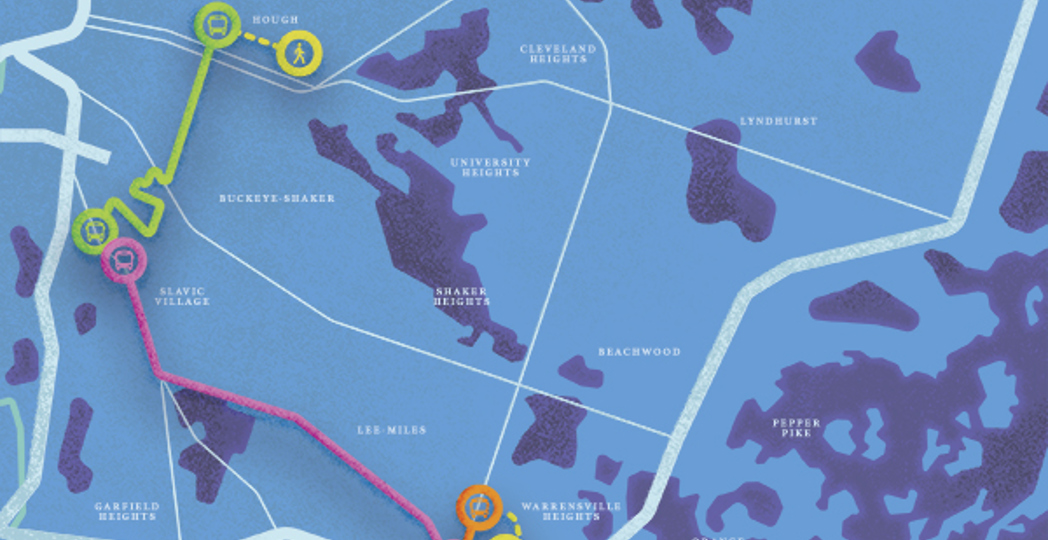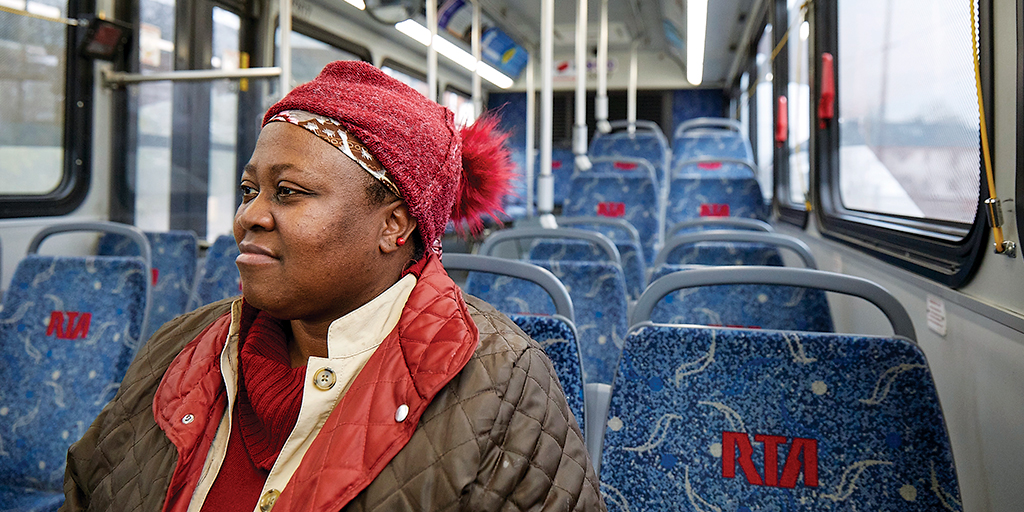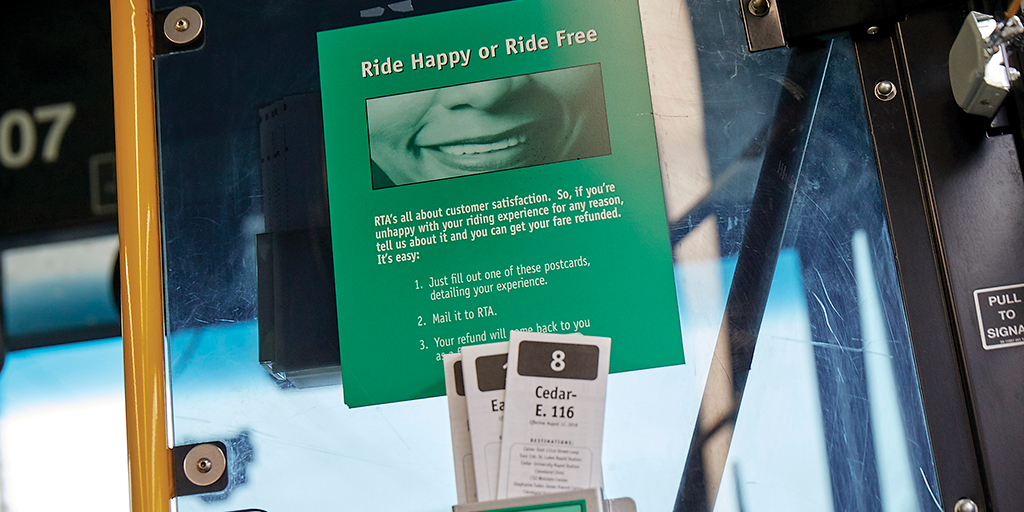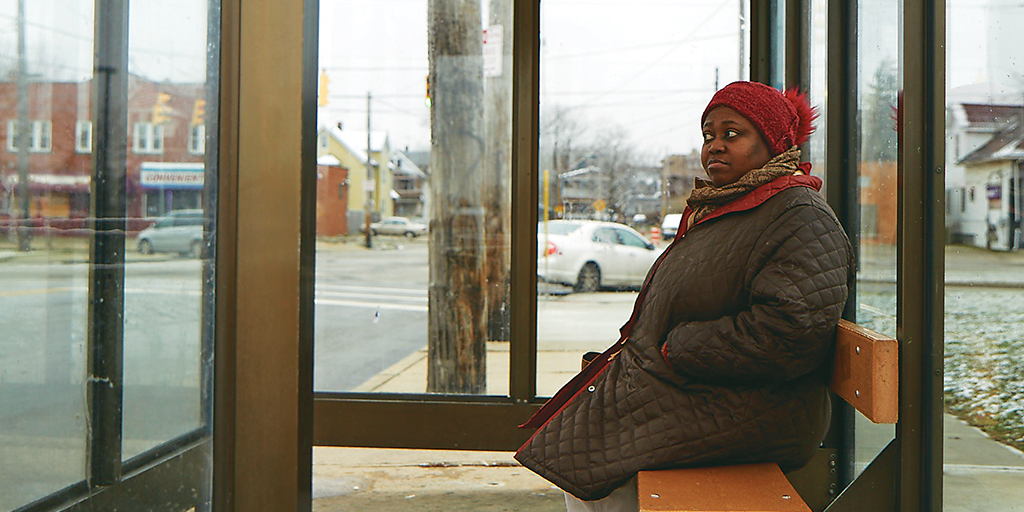Paradox Prize Aims To Get Carless Workers To Far-Flung Jobs
by Ken Schneck | Jan. 5, 2020 | 1:00 PM

Shannon Sullivan, Kevin Kopanski
La Queta Worley-Bell sits on the bench of a bus shelter looking east on Corlett Avenue near Martin Luther King Jr. Drive.
Remnants of a late-fall snow coat the ground and the rooftop of John Adams High School across the street. Though the glass of the shelter blocks Worley-Bell from some of the wind, she is still bundled up in a hat, gloves and puffy coat to protect her from the 22-degree chill.
She exudes patience as she sits with her arms crossed on her lap.
“I’m used to the waiting,” says the 47-year-old seasoned bus rider.
Fourteen minutes later, the No. 15 bus pulls up to the stop like a caravan ready to shepherd people through the cold streets.
Worley-Bell, whose mission today is grocery shopping at Dave’s Supermarket in Ohio City, slowly stands to board.
“This is one of the older buses,” she remarks as if she’s a mechanic.
She shows the driver her disability pass — she had screws put into her foot in 2017 — where her picture is completely faded from the well-worn ID card and sits down towards the front on the plastic bus seat with faded blue-and-pink patterned RTA-branded fabric that looks like it was lifted from the 1970s.
The aisles on these older buses are narrower than the newer models, which proves problematic for riders with strollers, wheelchairs or the plethora of shopping carts that crowd the interior at the beginning of the month when paychecks are exchanged for groceries.
Worley-Bell stares out the window and points out every neighborhood through which the bus passes, from the churches to the charter schools, from the beauty shops to Cuyahoga Community College’s new construction on its Metro campus.
Not only does she know these streets, but she knows them from these bus windows.
The lifelong Clevelander has never had a driver’s license, and only briefly had a car 30 years ago.
“My great-aunt gave me her old car for $200 when I was 18,” Worley-Bell remembers. “She was really old, so she couldn’t teach me how to drive. So, I let the car go. It sat, then just rotted.”
She spouts off numbers of bus routes by heart, having memorized which ones go where and on which days. From her home in the Union-Miles Park neighborhood, she spends 6 to 8 hours a day using a combination of the bus and the Rapid to volunteer at a church on West 65th Street, visit her 24-year-old daughter in the Detroit Shoreway neighborhood, go to church on Sundays (which requires an entirely different route, as some crucial bus routes don’t run on the weekends), and to look for work.
It is this last pursuit that proves difficult.
“It has to be some place I want, but it also has to be some place I can get to,” sighs Worley-Bell, who is currently unemployed. “That’s not always easy.”
Worley-Bell’s experience is not uncommon. Far from it, says Bethia Burke, incoming president for the Fund For Our Economic Future, a philanthropic collaborative devoted to improving the economy in the region.
“Northeast Ohio has been in a pattern of no-growth sprawl for decades,” she explains. “We have the same number of people and the same number of jobs, but they are spread over an ever-increasing footprint.”
The result is that the physical distance between people and jobs continues to expand at a rapid rate. For the average Northeast Ohio resident, the number of jobs close to where they live declined by 22% from 2000 to 2012, while the number of nearby jobs for those living in high-poverty neighborhoods in Northeast Ohio declined by 31%.
With farther to go to get to a job, people need to have a reliable, flexible means of transportation such as a car, but that’s something not available to the entire workforce.
Thus, individuals must turn to expensive ride-sharing services, depend on others for a lift or hop on public transportation, a method that may be dependable most times, but often isn’t direct, especially as available routes diminish the further you travel from the city’s core.
Solon is one of the fastest growing job hubs, says Burke. With four different bus routes from Cleveland’s Hough neighborhood, the shortest being an hour and 55 minutes with two transfers, commuting to work proves challenging for those who work at companies such as nut manufacturer King Nut Cos.
“In a car, it would be less than 30 minutes,” Burke says.
The results of this transportation morass are wide and varied. Employers in far-flung exurbs such as Mentor have a difficult time filling open positions in manufacturing. Potential employees don’t apply for certain jobs due to a lack of transportation. Current workers fall into absenteeism due to a sudden change in a bus route or a car pool that doesn’t show up.
Without a car, employees (potential or current) can’t get to their job. But without the job, they can’t afford a car.
That central quandary inspired the rollout of the Paradox Prize in 2019, a series of grants awarded by the Fund For Our Economic Future, the National Fund for Workforce Solutions, Greater Cleveland Partnership, Cuyahoga County, Cleveland Foundation, the Lozick Family Foundation and DriveOhio.
Designed to support early-stage concepts that address the transportation challenge, it’s named after the no car, no job/no job, no car transportation paradox. The creators hope it will inspire a wide range of possible solutions and motivate companies to change the logjam that prevents so many Ohioans from getting to work.
“We can’t think about business retention or economic expansion or even environmental sustainability without thinking critically and introducing new ideas about how the workforce actually gets to their jobs,” says Burke.
Since rolling out in June 2019, round one of the call for proposals netted more than 50 ideas for improving the mobility of Northeast Ohio’s workforce. The first batch of entries represented nonprofits, corporate entities, individuals and shared collective proposals.
Over the next three years, up to $1 million will be awarded to support up to 15 pilot programs. This includes winners from rounds one and two, such as Akron Metro which will test a door-to-door, on-demand car service connecting workers to jobs in Northern Summit County, and Manufacturing Works which will use church vans to transport employees in Glenville and Lee-Harvard to jobs in Solon and Strongsville.
The third round closes Jan. 15. As the ideas begin to launch, the very idea of transportation is being challenged.
“People need work and companies need people,” says Burke. “To bridge that gap, we have to fundamentally rethink how we look at transportation.”

Dominic Mathew flew into Cleveland Hopkins International Airport at 9 a.m. on a Friday in November and needed to get to work in Midtown by 10 a.m. for a phone call.
Though he is no stranger to public transportation — he grew up in India, where public transportation is de rigueur — he was not sure he would make his meeting on time if he hopped on the bus or the Rapid.
“I took an Uber, which cost me $20 and is a luxury I can perform,” says Mathew, the urban and regional planner for mobility innovations at the Fund For Our Economic Future. “For someone working minimum wage, it would have cost two hours of their time and there are plenty of people who can’t do that.”
At the Fund, he spends his working life immersed in thinking about transportation. Still, he notes that many individuals working in the transportation space rarely use public transportation themselves.
“How can decision-makers address the issues on a bus route if you have never ridden the bus route?” asks Mathew.
Before the creation of the prize, the Northeast Ohio Sustainable Communities Consortium, an Obama administration-funded public initiative, gathered professionals from 12 Ohio counties in 2013 to strategize how transportation could be improved in a way that achieved economic growth.
Undergirding this work was a 2012 Brookings Institution study indicating that out of the top 100 metro areas in the U.S., Cleveland lost the most jobs that are geographically within the area’s typical commute.
The work of the Consortium led the Fund for Our Economic Future to partner with the Solon Chamber of Commerce and Greater Cleveland Partnership to set up multiple conversations with various companies around Northeast Ohio to gather perspectives on transportation from the point of view of the hiring managers.
They discovered a central disconnect between workplace behaviors and awareness of mobility concerns.
On the front end, employers were asking potential employees in an interview whether or not they could get to work. For someone trying to get a job, there’s no opportunity in that conversation for the applicant to highlight scheduling trouble they might have with public transportation or a vehicle that may only be reliable for the next 30 days. Many employers won’t give an applicant a second glance if the answer is “no.”
“That interview is not the start of a problem-solving conversation,” says Burke.
Once hired, employers only saw a person showing up or not, but never questioned the rationale behind transportation issues that may be present. With low absenteeism, the barometer is solely, “Are they on time?”
Often there is complete lack of awareness about what preceded the employee arriving on-site.
“At one company, we outlined transportation issues to the CEO, who immediately responded, ‘I hear you, but no one here takes the bus,’ ” recalls Burke. “He walked out on the floor and asked the first person he saw how they got to work. That employee answered that he took the bus, explaining that he had to leave home two hours before his shift started to get to work on time.”
As a result of the Fund’s conversations with companies, employers were more aware of their employees’ transportation issues and wanted solutions.
This posed a problem for the Fund.
“We’re not set up to be a direct service provider,” says Burke.
The Paradox Prize was created to lift up ideas from all across Northeast Ohio, opting for a wide-scale approach that opened up a range of options, rather than charging one particular organization with solving the problem.
Mathew helped create the various criteria used to judge submissions, which include direct connections to jobs, scalibility, using existing infrastructure, practicality and simplicity, affordability, sustainability and measurable impact for low-income communities and people of color.
“The most effective solutions address transportation across all stakeholders and potential areas for impact,” says Mathew.
Connecting all of the disparate ideas is the central belief that transportation innovation can be a game-changer for employers, employees and the region itself. It’s something other nearby cities have done and done well, says Mathew.
“There is great transportation innovation happening in Pittsburgh, Detroit, Chicago and Columbus with exploring multimodality connecting various forms of transportation” says Mathew. “We just need people to jump in and start to try things.”

For many of the estimated 100,000 workers living in urban core neighborhoods in Northeast Ohio who need reliable transportation to job centers, riding the bus is not a choice — it’s one of their only options.
But thanks in part to the Paradox Prize, organizations across the region are looking at ways to open more paths up.
Ride-sharing service Share is looking to provide an alternative to public transportation and was among the first batch of Paradox Prize winners announced in August. A Columbus-based operation, it set up shop in Cleveland in the last year to introduce a wider audience to the idea of microtransit: small-scale, on-demand, multiuser transportation options.
“Everything that we’re used to is on demand, like your car in a driveway or calling an Uber,” explains Hoa Pyles McManus, the co-founder and chief of culture at Share. “We want to show people how things improve dramatically when you schedule in advance.”
Through support from the Paradox Prize, Share will be partnering with Express Staffing to help support the transportation needs of job seekers and workers in Euclid, Glenville and East Cleveland, who need to commute to job hubs in Painesville and Mentor.
Users will request the rides in advance via the invite-only phone app, allowing groups of riders to travel together.
“This not only gets people to their destination, but it helps eliminate single occupancy vehicles from the road and then reduces carbon emissions from our environment,” says Pyles McManus.
In Wayne County, transportation has already seen a transformation that makes it easier for carless workers and job seekers.
The City of Wooster turned their public transit operations over to another Paradox Prize grantee, Community Action Wayne/Medina, an anti-poverty agency whose 5,000 clients were some of the prime users of the system. CAW/M added a transit loop, extended hours of service and solidified a subsidized work-pass program for low-income Wooster residents.
Last spring, they introduced a second transit loop and put a bus stop near major employers such as ArtiFlex Manufacturing. The results have been astounding.
“In 2016, riders were under 500. Now there are over 1,600,” says Melissa Pearce, the president and CEO of CAW/M.
The $100,000 that they received from the Paradox Prize will enable CAW/M to build on their recent improvements with a new van-pooling service. It will be equipped with a dispatch software that will allow them to scale it county-wide.
“Right now, a cab ride from Orville to Wooster is $20-$25, and from West Salem to Wooster might cost you $40 for just one way,” says Pearce. “The only way to achieve economy of scale is to use vans, fill them and drive down the cost.”
Lake County will also be seeing an increase in vans thanks to support from the Paradox Prize. They are particularly needed on Tyler Boulevard, where employers such as Global Manufacturing Technology and Trailer Component Manufacturing are among the 300 employers with 7,500 jobs within the area’s relatively small footprint.
“Tyler is one of our most significant jobs corridors and many businesses have help-wanted signs,” says Joel DiMare, the director of administrative services for the Lake County Board of Commissioners.
The difficulty is that many of the open positions are entry-level manufacturing jobs, with many of the potential employees coming from outside of Lake County.
In order to help address that, Laketran — Lake County’s public transit operator — is in early testing phases on a new van service to help transport individuals who do not live in close proximity to jobs.
The projected benefits are as much for the employees as they are for the employers.
“If an employer can’t fill a job, they leave the area,” says Laketran CEO Ben Capelle. “If the job vacancy rate goes from 10% to 5%, we’ll know that this project is working.”
Aside from all the potential solutions, Mathew stresses that there is an inspiration factor embedded in the Paradox Prize, in which the programs develop past the paradox into being paragons.
“Even if it’s something as small as a church-van pilot program, when people see something and say, ‘This is something we can do!,’ that’s a success,” he says. “We want these pilots to act as this catalyst in people’s minds.”

Both Burke and Mathew are quick to point out that the projects emerging from the Paradox Prize are not a panacea.
“Fifteen pilots can’t change the mobility landscape for the 4 million people of Northeast Ohio,” says Burke.
Measuring the success of the Paradox Prize is a bit tricky as not all the metrics are easily assessed. On the surface, the Fund sees it as critical that all of the $1 million be dispersed.
Mathew highlights the importance of numbers, such as how many people are using the pilots, whether new jobs are being accessed or if commutes are being reduced.
Harder to measure is whether the overall conversation on mobility is shifting.
However, there are signs that these issues are saturating the larger dialogue, such as the presence of transportation discussions at City Club of Cleveland forums or an increase in businesses offering transportation options as a benefit, as they would health care or professional development.
But perhaps the most difficult metric of all to assess will be whether perception of those who don’t have a car and rely on public transportation has changed, resulting in a decrease of the social stigma surrounding hopping on the No. 8 bus or the Rapid’s Red Line. Mathew stresses that this perspective can only change if more people start using public transport. If they do, he says the benefits are far greater than getting from point A to B.
“Public transit forms the backbone of any transit system,” says Mathew. “The more people use it, the more we invest in it, and the more jobs are created.”
Worley-Bell needs no such encouragement. Public transportation is part of her existence.
Her father taught her how to use Cleveland buses when she was 13, and she taught her son and daughter when they were 7 and 9.
She has come to accept that there will be barriers with getting around the area, such as being randomly stopped by a police officer in March to check her ID card.
But overall, she believes in the public transit system, mostly because she has to in order to get around.
Later this month, she will start a home health aide program through the nursing school at Cleveland State University. Through a series of six-hour sessions, she will undergo training in the basic health care skills associated with being employed as a home companion to the elderly or those in need.
She is excited the training will move her closer to her life goal of finding a job where she can provide care to others.
All she has to do is get there.
“I have been riding these buses all my life,” Worley-Bell says with a laugh. “It sometimes takes a while, but I know how to get from here to there.”
For more updates about Cleveland, sign up for our Cleveland Magazine Daily newsletter, delivered to your inbox six times a week.
Cleveland Magazine is also available in print, publishing 12 times a year with immersive features, helpful guides and beautiful photography and design.
Trending
-
1
-
2
-
3
-
4
-
5










